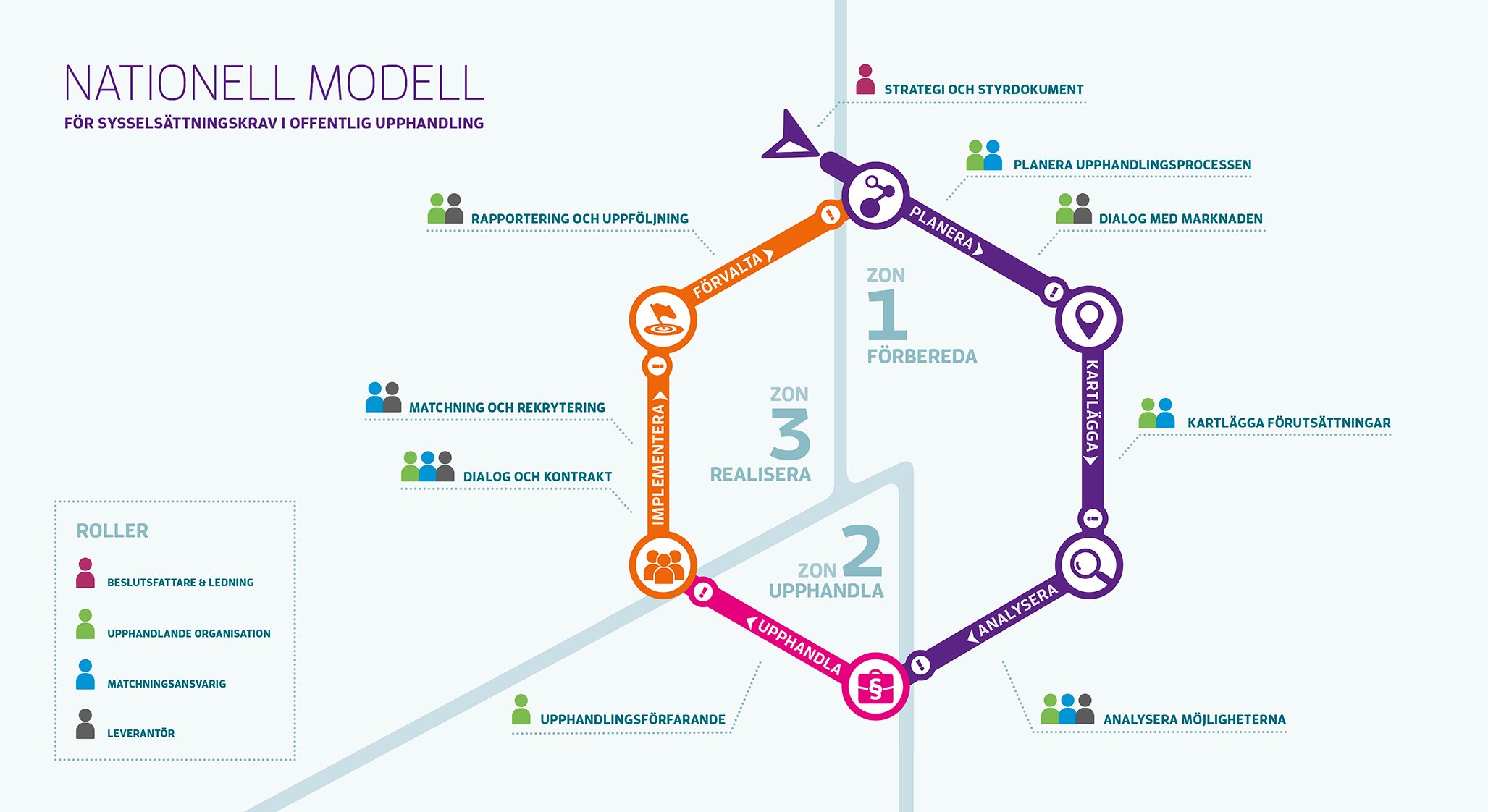Procurement with the aim of increasing employment
Public contracts can be used to help people who have difficulty finding work to enter the job market, resulting in improved skills supply. Here you will find a model for how it works.
Content
Employment requirements in public procurement means that a purchasing organisation places conditions in the procurement contract so that, for the contractual period, the successful bidder must provide employment, training, internship or traineeship for individuals who have difficulty entering the job market. Examples of those who could be given jobs, internship or traineeship according to these requirements are new arrivals, young people or the long-term unemployed.
Public procurement with employment requirements is one of several possible ways of helping people on the job market. Those who have difficulty entering the job market find employment, and companies are given new resources to help them grow and reach their full potential. Moreover, society saves money when unemployed people start working, increasing tax revenue.
In order to simplify this, the National Agency for Public Procurement has collaborated with a number of partners to develop support for employment requirements in public procurement.

Support has been set up for the roles involved and is made available for all stages of the strategic purchasing process.
- Decision-maker and management – those who initiate policy decisions and strategies for the organisation, such as politicians and officials.
- Contracting organisation – issuer of procurement contracts containing employment requirements, such as procurers, purchasers and project managers.
- Supplier – tenderer or supplier that has an interest in the employment requirements, such as companies or organisations.
- Job-matching service – works with job market issues and matches job seekers with employers. For example; labour market administrations or public/private employment agencies.
What is the purchasing process?
The model for employment requirements in public procurement is based on the purchasing process as illustrated by the National Agency for Public Procurement. A public purchase consists of so much more than the procurement itself.
The illustration above shows all the steps that comprise strategic purchasing from the perspective of the purchasing operation.
It is important to remember that the tasks can be carried out by different roles within the organisation. They may be done, for example, by purchasers, project managers, procurers or contract managers. In order for a procurement process that includes employment requirements to be successful, it must be clear within the organisation before the process begins which roles should take care of the various tasks.
Strategic and successful purchasing is thus teamwork between various parts of the organisation, the job-matching service, and to a great extent also in collaboration with the supplier.
The following documents are included in the support (in Swedish only):
Employment requirements in public procurement
At the political level – in the EU and nationally in Sweden—public procurement is considered one of several possible tools for achieving various objectives in society. These could be environmental, social or other social policy objectives. One important purpose of the European directives that govern public procurement is to use procurement as a way to effectively direct public funds whilst simultaneously contributing to achieving societal objectives.
The Europe 2020 strategy for smart, sustainable and inclusive growth also incorporates public procurement as an instrument that should contribute to the European Employment Strategy's employment and social inclusion goals, amongst other things.
Employment requirements in public procurement aim to improve the situation for people who have had difficulty in establishing themselves on the job market, reduce unemployment, increase employment, promote social sustainability and improve the availability of skilled personnel to suppliers. Job market policy programmes that are able to be combined with this can help job seekers gain skills that are in demand, thereby offsetting labour shortages amongst suppliers.
According to the 2014 EU Procurement Directive (2014/24/EU), a contracting organisation may impose special conditions on how a contract is to be fulfilled. National regulations regarding requirements for performing contracts (special contract terms) are found in chapter 17, section 1 of the Public Procurement Act (2016:1145 (LOU—lagen om offentlig upphandling))*.
*Equivalent regulations are found in the Utilities Directive (2014/25/EU).
According to the Directive, such conditions may include employment-related considerations. Contracting organisations are given considerable freedom to define the object of procurement and to include environmental and social considerations according to their own needs and preferences during the various phases of procurement.
The regulations on contract fulfilment are often highlighted as most appropriate for employment incentive measures, and the preparatory work emphasises opportunities for setting employment incentive requirements by applying contract fulfilment terms (see Government Bill 2016/17:195, including pages 292, 928 and 1,118).
Reserved contracts in public procurement
In connection with initial planning, it should also be considered whether reserved procurement might be used to reach the required employment objectives. In reserved procurement, only suppliers that meet certain requirements regarding their activities may participate, such as sheltered workshops or suppliers whose main purpose is social or professional integration for individuals with disabilities or who have difficulty entering the job market.
Reserved procurement/contracts (SV)
